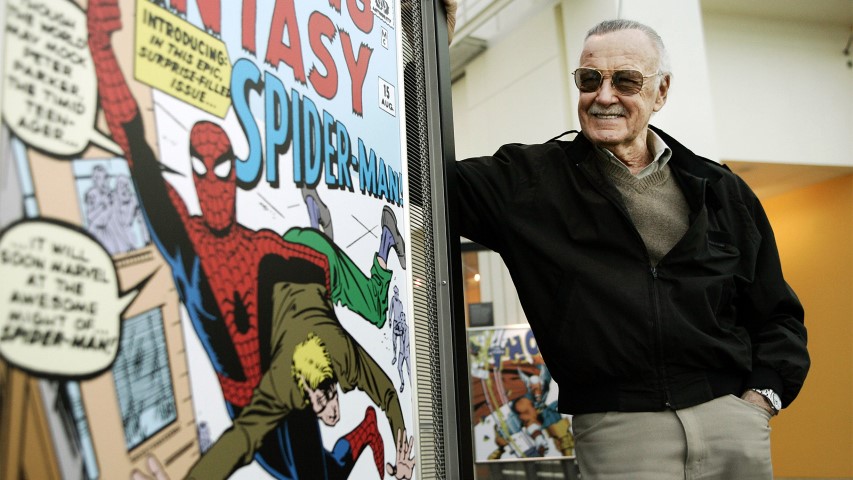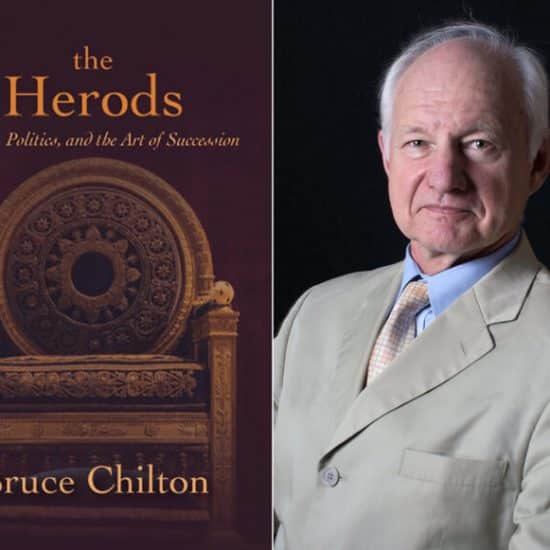(RNS) — “And a lean, silent figure slowly fades into the gathering darkness, aware at last that in this world, with great power there must also come — great responsibility!”
Those words, written by Stan Lee, appear in the momentous final panel of the first story to feature the Amazing Spider-Man, published in 1962’s “Amazing Fantasy #15.”
It’s a measure of how completely Lee’s stories have been subsumed into our collective cultural bloodstream that if you were to quote that line above to your average person on the street, many would make the link to the iconic web-spinning superhero.
 Stan Lee, creator of comic-book franchises such as “Spider-Man,” “The Incredible Hulk” and “X-Men,” smiles during a photo session in his office in Santa Monica, Calif, in 2002. Lee, the architect of the contemporary comic book, died at the age of 95. (AP Photo/Reed Saxon)With the equally iconic Lee’s death on Monday (Nov. 12) at the age of 95, it’s worth taking a step back to examine the long reach of the legendary writer/editor. Along with artists such as Steve Ditko (Spider-Man’s co-creator), Jack Kirby, John Buscema, John Romita, Don Heck, Gene Colan and so many others, Lee laid the sturdy foundations of what has collectively become one of the most significant storytelling endeavors in modern history.
Stan Lee, creator of comic-book franchises such as “Spider-Man,” “The Incredible Hulk” and “X-Men,” smiles during a photo session in his office in Santa Monica, Calif, in 2002. Lee, the architect of the contemporary comic book, died at the age of 95. (AP Photo/Reed Saxon)With the equally iconic Lee’s death on Monday (Nov. 12) at the age of 95, it’s worth taking a step back to examine the long reach of the legendary writer/editor. Along with artists such as Steve Ditko (Spider-Man’s co-creator), Jack Kirby, John Buscema, John Romita, Don Heck, Gene Colan and so many others, Lee laid the sturdy foundations of what has collectively become one of the most significant storytelling endeavors in modern history.
It’s worth pausing here to reflect on what a paradigm shift Lee and his collaborators’ approach to superhero fiction represented in the early 1960s.
Before then, Timely Comics (the company that eventually became Marvel) had been kicking around with a small roster of colorful crime fighters —most prominently Captain America, the Human Torch and the Sub-Mariner, all introduced during the Second World War. The big kid on the block was DC/National Comics, who inaugurated the comic-book superhero, with Superman and Batman modeling for the next several decades what the tropes of the genre would be.
While Superman, Batman, Wonder Woman, Flash, Green Lantern and the various other DC heroes endure to this day, Lee imagined a different kind of hero. His innovation in the ’60s — after several decades toiling in relative obscurity over stories that he increasingly felt didn’t particularly matter — was to create characters who struggled under the weight of everyday problems even while trying to live up to their heroic ideals.
His characters weren’t necessarily called to heroism but chose it all the same.
 Comic-book creator Stan Lee stands beside some of his drawings in the Marvel Super Heroes Science Exhibition at the California Science Center in Los Angeles on March 21, 2006. (AP Photo/Damian Dovarganes)The process toward these more human heroes began in 1961 with “Fantastic Four #1,” co-created by Kirby. That’s where that book’s titular quartet — Reed “Mr. Fantastic” Richards, Susan “Invisible Woman” Storm, Johnny “Human Torch” Storm and Ben “Thing” Grimm — decide to become do-gooders without much additional prodding after gaining otherworldly powers from an outer space anomaly.
Comic-book creator Stan Lee stands beside some of his drawings in the Marvel Super Heroes Science Exhibition at the California Science Center in Los Angeles on March 21, 2006. (AP Photo/Damian Dovarganes)The process toward these more human heroes began in 1961 with “Fantastic Four #1,” co-created by Kirby. That’s where that book’s titular quartet — Reed “Mr. Fantastic” Richards, Susan “Invisible Woman” Storm, Johnny “Human Torch” Storm and Ben “Thing” Grimm — decide to become do-gooders without much additional prodding after gaining otherworldly powers from an outer space anomaly.
Lee evolved the template somewhat with 1962’s “The Incredible Hulk #1,” again with Kirby. Here we had bookish and introverted nuclear scientist Bruce Banner, about to test the terrifying “Gamma Bomb” — his own creation. An act of enemy sabotage coupled with uncharacteristic bravery by Banner results in him risking his life to rescue a trespassing teenager just as the bomb explodes, enveloping him in “the full force of the mysterious Gamma Rays!”
The tale of a man of science inventing an instrument of mass destruction and being immediately gripped with conscience over impending loss of life marks Banner as a comic-book Oppenheimer of sorts, his last-second rescue of the boy serving as his own version of “I am become death.”
As Banner finds himself transformed by the bomb and his own hubris into a brutal personification of rage itself, the Lee template for Marvel characters is well and truly set.
Flawed characters.
Human failings.
Feet of clay.
But still nonetheless striving to do right, even when doing right comes at considerable personal cost.
Thus we have bullied teenager Peter Parker, who initially uses his newfound spider-powers to forge a path as a TV celebrity until his decision to let a burglar go — because “I just look out for number one!” — results in the same burglar murdering his beloved uncle.
It’s a parable that could sit comfortably in an O. Henry anthology.
And so it goes. Iron Man. Daredevil. Black Panther. The Silver Surfer. Too many others to even list.
But all embody the same ethos of flawed people doing their best to do good. The Marvel characters have long since transcended their four-colors-on-newsprint origins, but the simple formula behind their success is as potent today as ever.
Through the roster of colorful characters Stan Lee was able to demonstrate for several generations of the young (and the young at heart) how heroism comes not from superpowers but from the willingness to use what we have to do what we can, however we can.
In the immortal words of the man himself, “’Nuff said.”
Zaki Hasan, who teaches at San Jose State University, has been a media scholar and critic for more than 20 years.

